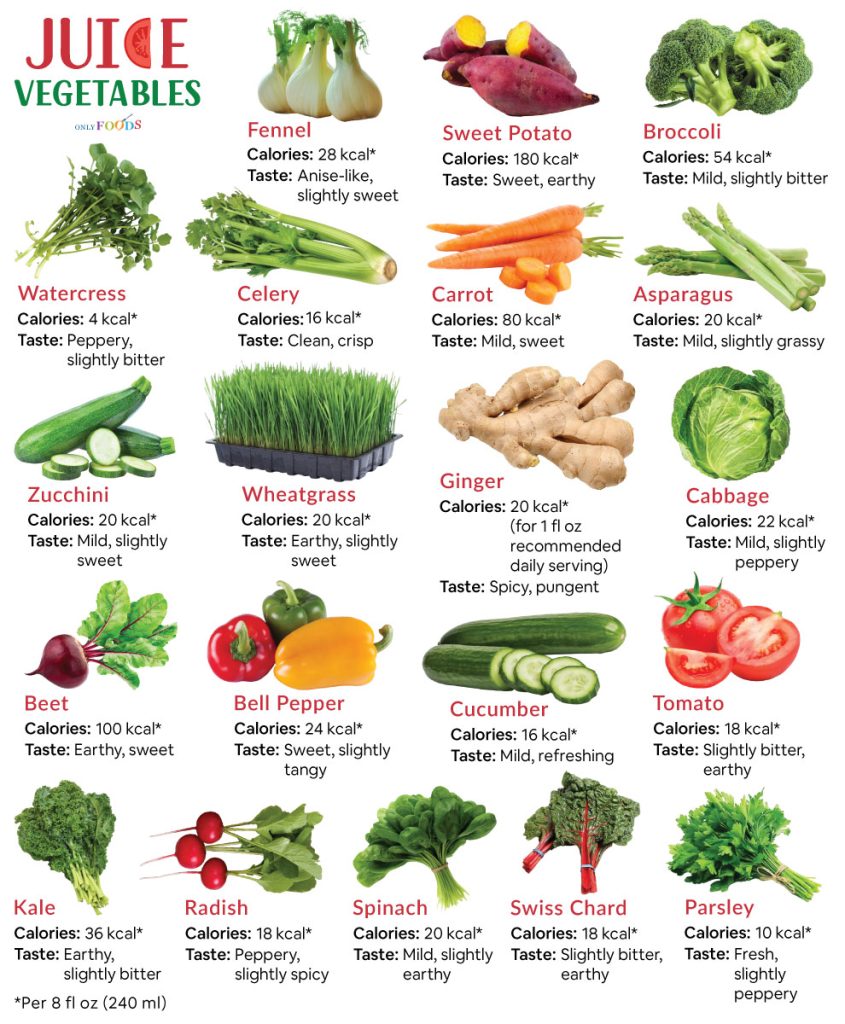Best Vegetables for Juicing
As evident from the name, juice vegetables can be used for making juice. They are a healthier juice option than fruits because vegetables contain less sugar and more fiber.
But juicing vegetables may only produce palatable results if the ingredients have the correct taste and texture. It is also essential to combine suitable vegetables and fruits to complement each other and balance each other’s taste and nutritional value. Mixing things up also provides a greater variation in the daily juice regime, keeping things from getting monotonous.
Different Types of Vegetables Commonly Used for Juicing
The table below lists some of the best vegetables for making juice in terms of taste and flavor.
Deciding on the healthiest vegetables for juicing is difficult because each offers different yet essential nutrients. Their amount in a juice typically varies based on the recipe. Still, knowing the calories present in each helps when combining them with other vegetables and fruits.
| Name of Vegetable | Calories per 8 fl oz (240 ml) | Taste and Flavor | Combines Well With |
|---|---|---|---|
| Carrot | 80 kcal | Mild, sweet; balances stronger flavors | Apples, oranges, ginger |
| Celery | 16 kcal | Clean, crisp; slightly peppery | Cucumbers, apples, lemon |
| Beet | 100 kcal | Earthy, sweet; sometimes slightly bitter | Apples, carrots, ginger, lemon |
| Cucumber | 16 kcal | Mild, refreshing; slightly sweet | Mint, cilantro, apples, lime |
| Spinach | 20 kcal | Mild, slightly earthy | Apples, pineapples, cucumbers, leafy greens |
| Kale | 36 kcal | Earthy, slightly bitter | Apples, pears, pineapples, lemon |
| Tomato | 40 kcal | Sweet, tangy; can be savory | Basil, celery, bell peppers, carrots |
| Cabbage | 22 kcal | Mild, slightly peppery | Apples, pears, ginger, lemon |
| Wheatgrass | 20 kcal | Earthy, slightly sweet | Apples, oranges, cucumbers |
| Broccoli | 54 kcal | Mild, slightly bitter | Apples, lemons, ginger |
| Swiss Chard | 18 kcal | Slightly bitter, earthy | Apples, pineapples, oranges |
| Parsley | 10 kcal | Fresh, slightly peppery | Apples, lemon, cucumber, celery |
| Fennel | 28 kcal | Anise-like, slightly sweet | Apples, oranges, pears, ginger |
| Radish | 18 kcal | Peppery, slightly spicy | Carrots, cucumbers, apples |
| Zucchini | 20 kcal | Mild, slightly sweet | Cucumbers, apples, lemon |
| Sweet Potato | 180 kcal | Sweet, earthy | Carrots, cinnamon, nutmeg |
| Ginger | 18 kcal (1fl oz or 30 ml recommended daily serving) | Spicy, pungent | Apples, carrots, citrus, pineapple |
| Bell Pepper | 24 kcal | Sweet, slightly tangy | Tomatoes, cucumbers, carrots |
| Watercress | 4 kcal | Peppery, slightly bitter | Cucumbers, apples, lemon, mint |
| Asparagus | 20 kcal | Mild, slightly grassy | Cucumbers, lemon, parsley |
The above list contains only the leafy greens most commonly used for juicing. It is worth noting that all leafy greens, such as lettuce, bok choy, and collard greens, are generally suitable for juicing and are often added to vegetable juices.
When vegetables are added to a juice, they can affect it in more ways than just adding to its taste and nutritional value. Vegetables with a high water content, like celery, cucumber, and zucchini, contribute to the fluid volume of the juice. The colorful carrots, beets, and spinach make the juices more vibrant and delicious.
FAQ
Frozen vegetables are good for juicing as long as they are properly thawed. Juicing them while frozen can result in a slushie-like thickness and texture that would not taste like juice.
A juicer’s job is to extract the juice from vegetables (and fruits) and separate it from pulp. While this preserves most of the vitamins, minerals, and other nutrients in a concentrated form, juicing removes the fibers in the pulp. So, juicing does remove some essential nutrients, and it should not replace whole vegetables in a balanced diet.
The high-calorie vegetables in the above chart, like carrot, kale, and beet, are good for making a juice blend that gives a lot of energy. The exact number of calories will depend on what other ingredients are added to the juice.
Though vegetables are not what comes to mind when thinking about adding more proteins to your diet, spinach (2.9 gm/100 gm), kale (2 gm/100 gm), and broccoli (2.8 gm/100 gm) are some high-protein juice vegetables.

